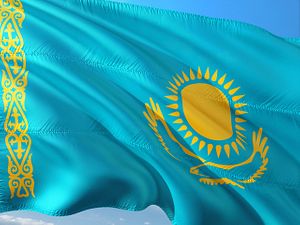Kazakhstan witnessed a wave of protests in 2019, largely triggered by the resignation of long-time President Nursultan Nazarbayev and by an impatient generational shift. The protest sentiment culminated in a mishmash rally at Republic Square in Almaty, organized and participated by a variety of groups on December 16, the country’s Independence Day.
At least four different groups of activists organized pickets and rallies around the square, also called “New Square,” opposite the main administrative building of Almaty, the largest city in Kazakhstan. The location was significant: at the corner of Zheltoksan (December) Avenue and Satpayev Avenue, a monument celebrates the 1986 protests against the Soviet government. The protests were harshly repressed by the Soviet security forces. The place and the name (Zheltoksan) remain symbols of Kazakhstan’s independence.
The two most prominent groups to assemble – having called for separate rallies – were the Democratic Choice of Kazakhstan (DVK) and Oyan Qazaqstan!. The DVK was revived last year by Mukhtar Ablyazov, a political opponent to Nazarbayev living in exile in France. Oyan Qazaqstan! was born in early May as a disruptive youth movement.
In the lead-up to the protest, Oyan published a promotional video calling for participation in the protest that showed a young man paying homage to the monument to the city, under which lies a bronze reproduction of the constitution and the handprint of Nazarbayev. Upon measuring his hand with the Father of the Nation’s, the young man finds that his hand is suddenly covered in blood. During their rally on December 16, Oyan members stood under the monument holding banners condemning state repression and held a minute of silence while raising their “blood-stained” hands. Through this action, Oyan was the only group to draw a direct connection between the massacres of 1986 and 2011, which injured and killed hundred of students in Almaty and oil workers in Zhanaozen respectively.
Minutes earlier, a hundred meters to the west, near the monument to the Zheltoksan events, a few DVK supporters had given speeches on Ablyazov’s integrity as a leader, claiming that instead the Nazarbayev family had stolen everything from the country. “The old man must go!” the demonstrators shouted, a slogan that the DVK and its supporters have used for several years. Nazarbayev, who served as president of Kazakhstan for three decades, resigned in March this year but still retains seemingly unlimited power in the country.
The squares and monuments were also visited by the newly-formed Democratic Party of Kazakhstan, headed by Zhanbolat Mamay, a civic activist who was jailed for alleged links to Ablyazov in 2017, and by the so-called Zheltoksantsy, who bring flowers and prayers to the monuments every year in remembrance of the 1986 events.
While Oyan and the Democratic Party’s actions were organized and short, the rest of the groups were a haphazard collection of activists that gave somewhat unstructured speeches of anger and dissatisfaction toward the government. While activists were shouting in solidarity with ethnic Kazakhs suffering repression in neighboring China, high-level local authorities arrived at the square and asked the crowd to disperse, since the rally had not been authorized in advance. Importantly, this warning came around two hours after the start of the protest, not just minutes after the first speeches, as in past instances.
Still, no one was arrested, at least as long as the rally stayed in the square. Police kept a vigilant eye on the remaining 100 demonstrators, who suddenly decided to march on Zheltoksan Avenue. At this point only, they were met with some police resistance, which they chose to ignore, eager to bring the protest to the “Old Square,” one kilometer to the north. When the demonstrators attempted to cross one last police block, security forces intervened en masse and arrested around 40 people. Brought to a central police station, the arrests provoked indignation among other activists, who came out in support. Most detained demonstrators were released after a few hours.
In the capital Nur-Sultan, police arrested over 50 people who marched too close to the Akorda, the presidential palace, generally off-limits to civic actions. Ahead of the planned rally, police detained several activists and journalists, among which was Lukpan Akhmediyarov, a journalist from Uralsk, who had also been detained last year in similar circumstances. These typical repressive practices have been employed for decades, but there could be change on the horizon.
On December 20, at a meeting of the National Council of Public Trust, Tokayev unveiled a package of potential reforms aimed to facilitate access to political activity. Besides halving the number of signatures required to form a party to 20,000, Tokayev also said that the government will reverse the principle for “applying for rallies.” Now, a notification by the organizers, recognized by a local administration, should suffice. “It is time for both society and the state to adequately relate to the public expression of position,” Tokayev said. “We need to understand that rallies are not only a right, but a responsibility.”
While analysts continue to concentrate on the two-pronged presidential system, assuming that Tokayev and Nazarbayev are alternatively competing and cooperating, it is important to note that these proposed reforms could go a long way toward the opening of the political arena. Now it will be the task of the most staunch opposition to make itself heard and navigate the still hostile environment of Kazakhstan’s politics.

































